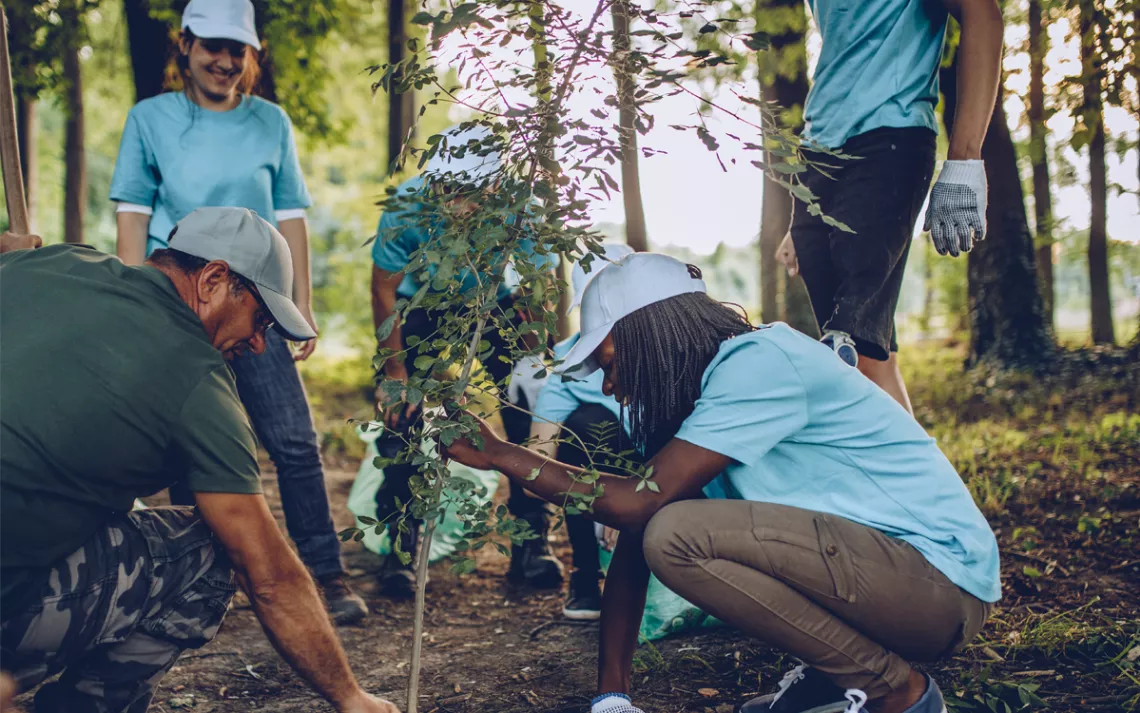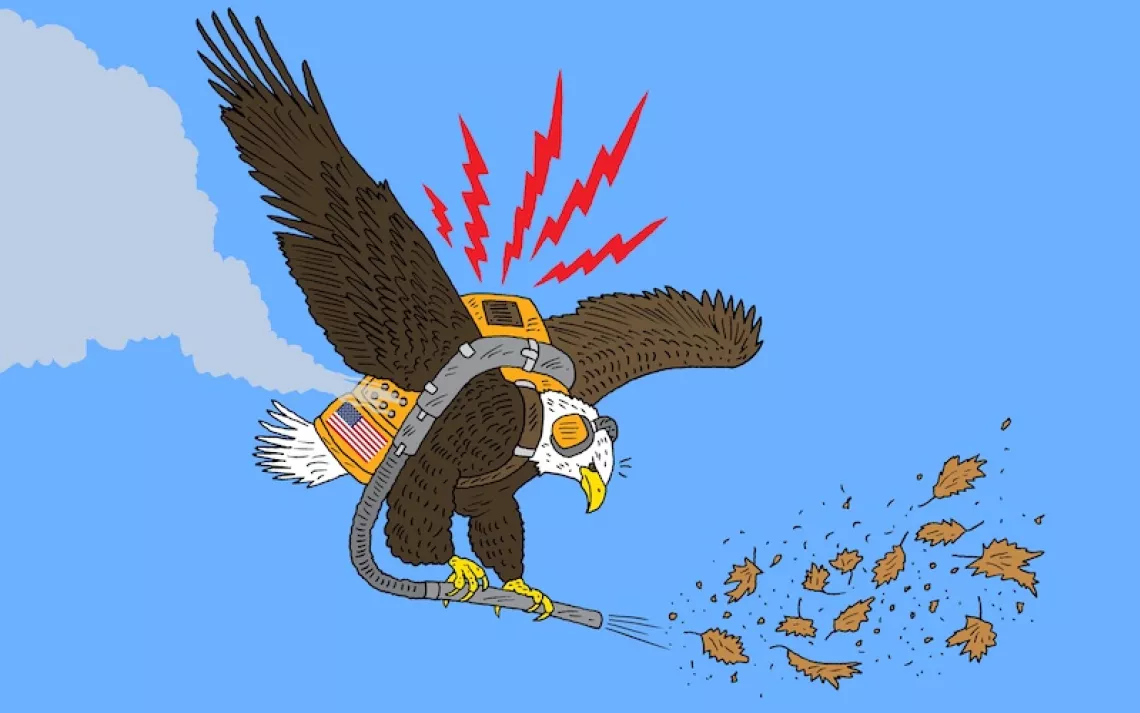All Together Now
How a Civilian Conservation Corps could help address the global-warming emergency

Photo by South_agency/iStock
In the spring of 1933, a newly inaugurated President Franklin Delano Roosevelt was facing a confluence of environmental and economic crises. The Ohio and Mississippi River basins were flooding. The Great Plains were choked with dust. More than a quarter of Americans were out of a job.
Roosevelt’s response to these colliding forces was to create a Civilian Conservation Corps that put young men (and only men) to work preserving soil, building trails and roads, and fighting fires. “In creating this Civilian Conservation Corps, we are killing two birds with one stone,” Roosevelt said during a fireside chat in May 1933. “We are clearly enhancing the value of our natural resources and, second, we are relieving an appreciable amount of actual distress.”
The American landscape we’re living in today is, in many ways, similar to the one Roosevelt inherited. The lockdowns imposed to stem the spread of COVID-19 have sparked the worst economic slump since the Great Depression. Heavy rains flooded the Midwest this spring, and an above-average hurricane season could do the same to the East Coast soon. Most of the West is in a historic drought, and large sections of the region are on fire.
It’s against this backdrop that President Joe Biden has proposed revitalizing the New Deal–era program. A single sentence in Biden’s American Jobs Plan calls for mobilizing an army of workers to conserve nature and combat the climate crisis: “This $10 billion investment will put a new, diverse generation of Americans to work conserving our public lands and waters, bolstering community resilience, and advancing environmental justice through a new Civilian Climate Corps, all while placing good-paying union jobs within reach for more Americans.”
Now, some legislators are trying to make that vision a reality. In April, Senator Ed Markey of Massachusetts and Representative Alexandria Ocasio-Cortez of New York, both Democrats, introduced a new bill that fills in some of the details of Biden’s ambitious idea. Dubbed the Civilian Climate Corps for Jobs and Justice Act, it would put 1.5 million Americans to work building climate-resilient infrastructure, reducing carbon emissions through renewable energy and conservation projects, and helping communities recover from climate disasters. It would grant corpsmembers many of the provisions on Democrats’ “social infrastructure” wish list, including a $15 an hour salary, full health care, and childcare services. Corpsmembers would also receive training and education to help them transition into union jobs.
“It is now this generation’s turn to answer the call and meet the historic challenges of our time,” Markey told Sierra via a press secretary. “We don’t have time for incrementalism. We don’t have time for Herbert Hoover–type complacency. This moment demands big, bold, progressive change. This is our FDR moment.”
Much of the environmental community hailed the idea. “This new iteration of the CCC offers us a once-in-a-generation opportunity to create good jobs for every young person who wants one and to help ensure their safety in a climate-changed world,” wrote Michael Brune, the executive director of the Sierra Club. “We owe it to the next generation to seize this moment.”
Varshini Prakash, the executive director of the youth-led Sunrise Movement, said in a statement, “There are millions of us looking for good work, and so much good work that needs to be done.”
“What if we ensured people had good jobs teaching, taking care of our elderly and retrofitting hospitals, and expanding renewable energy instead of working a shitty job at Amazon making Jeff Bezos richer?” she said. “Young people are ready and excited to get to work.”
A modern Civilian Climate Corps like the one Biden, Markey, and AOC are proposing also has wide bipartisan support among voters nationally. A recent survey of more than 1,200 likely voters conducted by Data for Progress, a progressive think tank, found that 65 percent of respondents support the idea of a Civilian Climate Corps, with the highest support among young and rural voters. Half of those under the age of 45 said they would consider working in the corps if a job was available to them.
There are a few notable differences between the original, Depression-era corps and the modern one proposed by Markey and AOC. The original corps only enrolled young men. Its camps were segregated. There was an entirely separate program for Native Americans, who often worked to develop their reservations for white tourists. By contrast, at least half the modern corps’ projects would take place in communities of color and rural and urban low-income communities. Half of the corpsmembers recruited would be from those same communities. The modern corps would also respect tribal sovereignty and guarantee that at least 10 percent of its environmental justice funds went to tribal communities.
“The original CC is a great model for a new Civilian Climate Corps, but only if we are aware of the historical failures of that original program,” said Neil M. Maher, an environmental historian at Rutgers University and the author of Nature’s New Deal: The Civilian Conservation Corps and the Roots of the American Environmental Movement.
Reforestation and tree-planting is one area in which a new CCC could learn from the old CCC. Planting trees was one of the things the OG CCC did best. All told, its recruits planted more than 3 billion trees and transformed an area larger than the state of Connecticut. But the original CCC also sowed some lasting ecological problems. In trying to prevent soil erosion, it introduced fast-growing non-native species such as kudzu and honeysuckle. It planted single species of trees in unnaturally straight rows. It drained wetlands to control mosquitoes. It split wild areas with roads. It built more than 318,000 dams.
“Scientific ecology was in its infancy at this time, so the Roosevelt administration could ignore a lot of the warnings from ecologists,” Maher said. “A new and improved corps would need to be guided by scientists and avoid the ecological blunders of the original CCC.”
Equipped with the latest findings from restoration ecology and forest management, the Climate Conservation Corps could make reforestation a pillar of its work. Biden has pledged to reduce US greenhouse gas emissions by more than 50 percent below 2005 levels by 2030. To meet that goal, the nation’s forests would need to expand so that they pull 20 percent more carbon dioxide out of the air than they do today. According to a recent study of national forests published in the Proceedings of the National Academy of Sciences, this would mean reforesting at least 81 million acres.
The Markey-AOC bill is still just that—a bill. Congress needs to weave it into Democrats’ $3.5 trillion climate and infrastructure package for it to become law. Even if a new and improved corps is created, how much it can do to help combat climate change is very much an open question.
Mark Paul, an environmental economist at the New College of Florida, said the Markey-AOC bill is not big enough to meet the scale and severity of the climate crisis. Over its nine-year existence, the original Civilian Conservation Corps employed more than 3 million people and spent more than $30 billion—equivalent to more than $500 billion today. By contrast, the Markey-AOC bill proposes spending $132 billion to employ 1.5 million Americans over five years.
"The $132 billion laid out by Markey and AOC is an excellent starting point, but even that is, I think, too small," Paul said. "History should be our guide, and it shows that going big has real benefits."
Reducing greenhouse gas emissions is just one of those benefits. It might seem a bit rosy, but it’s possible that by connecting young Americans with each other across lines of race, class, and geography, a revitalized CCC could (to steal Biden’s campaign slogan) help restore the soul of a divided nation.
Here’s one example: Paul said that on a recent road trip out West, he stopped at Grand Canyon National Park. He was taking the bus to a trailhead when the bus driver started to tell a story about his grandfather, who helped build the trail Paul was headed to. The bus driver said it was his grandfather’s proudest moment. “Not only did this program provide jobs and improve the nation’s environment and our park system,” Paul said, “it provided people with a sense of dignity, a sense that they were contributing to their community, a sense of hope.”
This article has been updated since publication.
 The Magazine of The Sierra Club
The Magazine of The Sierra Club






